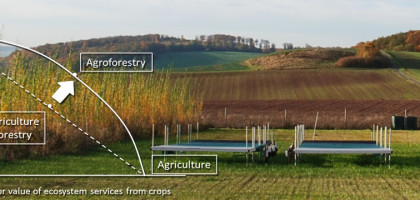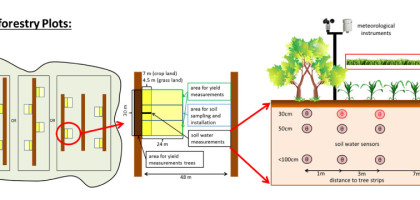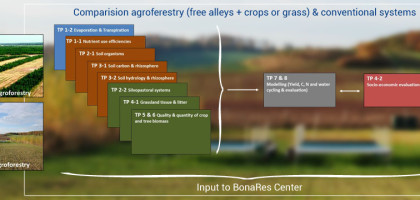Central objective
Central aim of our project is to evaluate whether and under which site conditions agroforestry in Germany can be a land use alternative that is ecologically, economically and socially more sustainable than conventional agriculture.
Central hypothesis
On marginal sites and sites with high potentials for leaching losses or soil erosion, innovative agroforestry systems are ecologically and economically more sustainable and socially more acceptable than conventional arable farming systems and, thus, improve the societal sustainability of modern agriculture.
Relation to the proposal call ŌĆśSoil as a Sustainable Resource for the Bioeconomy ŌĆō BonaResŌĆÖ
The BonaRes-SIGNAL collaborative proposal refers to the funding objectives of the tender ŌĆśSoil as a sustainable Resource for the Bioeconomy ŌĆō BonaResŌĆÖ in multiple ways:
- Within the BonaRes-SIGNAL consortium, we plan to evaluate innovative agroforestry systems (arable land or grassland with strips of fast growing tree species) which are land use systems with a high potential to contribute to the sustainable supply of food, feedstuff as well as raw ma-terials for the Bioeconomy.
- We choose an integrated approach by studying different environmental compartments which are regarded as critical for the studied land use systems.
- In BonaRes-SIGNAL we will study how soil functions can be optimized for agricultural production, while at the same time reducing the negative impacts on the environment (e.g. nitrate leaching, erosion, CO2 emissions).
- In this interdisciplinary project, we will investigate how management in agroforestry systems improves the habitat for soil biocoenosis, leading to more optimal soil functions compared to conventional agricultural practices.
- Our project will link information on the functional diversity of the soil community with their activities, processes (e.g. decomposition, gross N mineralization, gross N nitrification) and microbial residues, which has rarely been done before.
- The sustainability of the agroforestry and conventional systems will be evaluated through the efficiency of nutrient cycling and water use.
- Our project will be adapting and applying existing computer models that will include simulation of functions and interactions of soil ecosystems with the help of new and existing data on ag-roforestry field experiments.
- We will study the profitability and social acceptance of agroforestry systems in different regions of Germany.
Agroforestry may help to improve the image of an agricultural enterprise or region and may thus contribute to an improved societal sustainability of modern agriculture.
Scientific objectives and hypotheses
- To achieve an optimal input of root and leaf litter of crops, grass and trees so that the composition of the soil community, its functions (litter decomposition, N & P mineralization, N, P, K, Ca, Mg retention), and related soil properties (water holding capacity, aggregate stability) promote the efficient use of the nutrients N, P, K, Ca, Mg and water.
Hypothesis: Compared to conventional agriculture, agroforestry systems improve soil biological functions, like litter decomposition, N & P mineralization, N, P, K, Ca, Mg retention and related soil properties (water holding capacity, aggregate stability), which in turn will improve their nutrient response efficiencies and water use efficiency. - To improve management (by choice of crop and trees, above- and belowground pruning, distance to tree rows) directed at the efficient functioning of roots and rhizosphere, including: the stimulation of microbial activities, optimal acquisition of water and nutrients and increased C input into the soil.
Hypothesis: Roots and rhizosphere of agroforestry systems can be managed (e.g. by choice of crop and trees, above- and belowground pruning, distance to tree rows) to stimulate the comple-mentary use of resources (water, nutrients) by trees and crops. This includes stimulation of root exudates that can alter the soil properties in a way that is optimal for the acquisition of water. - To model the complex interactions between the soil biological community, rhizosphere, nutrient cycling, water use and plant productivity in agroforestry and conventional agricultural systems (including competition for and complementarity of resources), for the evaluation of the ecological sustainability of both systems.
Hypothesis: Successful evaluation of the sustainability of complex systems like agroforestry and conventional agriculture crucially depends on modelling tools that include competition for soil nutrients and water and use of complementary nutrient and water resources. - To conduct an economic analysis on the implementation of agroforestry systems at the farm level and to conduct an empirical acceptance analysis and societal valuation of agroforestry systems.
Hypothesis: In regions with marginal soil and climatic conditions and in areas with soils endangered by soil erosion and nitrate leaching, innovative agroforestry systems are economically sustainable and socially more acceptable than conventional arable farming systems and, thus, im-prove the social/societal sustainability of modern agriculture. Higher social acceptance of agroforestry systems can be observed in all types of regions, i.e. in regions with marginal as well as high productivity conditions.


